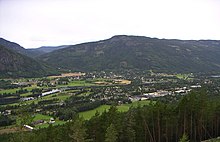Hallingdal
Hallingdal is a valley and a historic landscape in Fylke Viken in Norway . It includes the municipalities of Flå , Nesbyen , Gol , Hemsedal , Ål and Hol and has around 20,000 inhabitants.
geography
Hallingdal is approximately 150 km long. It runs from Gulsvik at the northern end of Krøderen in a north-westerly direction until the Hemsedal branches off in Gol. The main valley then continues in a south-westerly direction towards Geilo and Ustaoset . The Hallingdal landscape also includes the adjacent side valleys and mountain regions. In terms of height, the area extends from the former seabed at Gulsvik (today 150 m above sea level) to the high mountains (at 2000 m). About 70% of the landscape is over 900 m above sea level.
Riksvei (RV) 7 and Bergenbahn use the Hallingdal.
History and culture
The Hallingdal region has ancient roots and was part of Vestlandet in prehistoric times . Old roads in the western part of the country went through Valdres and Hallingdal towards Røldal to Odda . Because of this connection, Hallingdal, like the neighboring region of Valdres, was settled with a population originally from the Vestland, who accordingly spoke a western dialect. This fact was the reason that these two valleys were added to the diocese of Stavanger by Cardinal Nicholas Breakspear , the then papal legate for Scandinavia . Later the Oslo region lagdømme and in 1631 the bishopric of Oslo was added.
Hallingdal is the region of origin of the folk dance called Halling and, besides Valdres, the only area in which the ancient Bordunzither Langeleik is still played.
Nesbyen is the seat of the Hallingdal Museum .
See also
Web link
- Official website ( Norwegian )
- The Hallingdal , norgeskart.no
Individual evidence
- ↑ Befolkning , Statistisk sentralbyrå , accessed on April 11, 2020 (Norwegian)
- ↑ Om Hallingdal , hallingdal.no, accessed April 11, 2020 (Norwegian)
